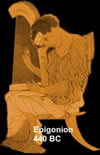 The epigonion is the harp-like instrument you’ve seen on a million Grecian vases. (Not the little lyre; the huge 40-stringed beast.)
The epigonion is the harp-like instrument you’ve seen on a million Grecian vases. (Not the little lyre; the huge 40-stringed beast.)
They stopped being made centuries ago, but we do have some fragments of medieval epigonions and some descriptions in the historical record.
Using those clues and computer modeling technology, researchers at the Ancient Instruments Sound/Timbre Reconstruction Application (ASTRA) have recreated the dulcet tones of the epigonion.
The physical modelling sound synthesis technique aims in fact to use a set of equations and algorithms that describe the physical materials used in the ancient instruments to generate physical source of sound. In other words, the basic idea is to recreate a model of the musical instrument and produce the sound by simulating its behaviour as a mechanical system.
For example, to model the sound of a drum, there would be a formula for how striking the drumhead injects energy into a two dimensional membrane. Thereafter the properties of the membrane (mass density, stiffness, etc.), its coupling with the resonance of the cylindrical body of the drum, and the conditions at its boundaries (a rigid termination to the drum’s body) would describe its movement over time and thus its generation of sound.
It actually sounds pretty damn good. I thought it would be more midi/computery sounding, but if I didn’t know it was virtually produced I wouldn’t have guessed.
For more music played on digitally-recreated historical instruments including Bach fugues complete with string profiles, see ASTRA’s download page.
“t actually sounds pretty damn good. I thought it would be more midi/computery sounding, but if I didn’t know it was virtually produced I wouldn’t have guessed.”
I think that’s the point. What with the modeling of the materials and all that. It sounds beautiful, and it’s an amazing bit of tech. :boogie:
Yabut I didn’t think they’d be as good at is as they are. It opens a whole new world of opportunities.
Next up: making castrati sing again. The one recording we have a castrato sounds like shit.
The human voice/anatomy would probably be way hard to model. It’d probably be easier just to make more castrati. :ohnoes:
Anonymous?! Whoops. Yeah, that was me.
Daaamn, you cold.
This kind of modelling is pretty impressive, but doing a singing voice is a whole ‘nother thing. The voice is the most complex instrument there is, and our brains are really well wired to discerning subtle distinctions in voices.
On a related note, there are scraps of ancient Greek music notation that have survived, some work’s been done on figuring out how the tunes went, but I don’t think any full pieces have been discovered.
That makes sense. What are the mechanics of a castrato’s voicebox anyway? You’d need some kind of autopsy data.
Very cool. The ASTRA folks need to get their grubby hands on those scraps so their virual epigonion can play actual ancient tunes instead of medieval and later.
Aha! Found a guy doing the First Delphic Hymn to Apollo (c138BCE) on a lyre. Same guy does the Song of Seikilos, apparently the oldest known complete piece of music (it’s short) known in notation, and it’s a drinking song from an epitaph!
Pretty cool sentiments for a tune that’s survived so much time to be played again…
That is totally fucking cool. I’m tearing up! Really!
Why, if they had all this information, didn’t they simply build a new epigonian? Okay, the software is cool, but it introduces the extra variable of the algorithms being right, which is hard to prove, whereas a physical model made with the correct raw material is more likely to be close to the original.
Well, I think actual instrument making is outside of these fellows’ purview. They’re technogeeks, not shop geeks.
It would be great if they shared the epigonion blueprint with craftsmen who specialize in making musical instruments.
Way cool! You can almost imagine someone sitting there plucking those strings. Sounds almost like….what do ya call it? The instrument from Thailand where it is shaped like a table, only with strings that you pluck instead of a hard table top? Yeah. sounds sort of like one of those.
Just so ya know, there are quit a few programs out there that synthasize instruments very accurately, no midi whatsoever. TBH, I have no idea why midi even exists any longer.
For an easy, simple sythesis program, Macintosh’s Garage Band is always fun to tinker around with. Even though I am not exactly a Mac fan. Garage Band is still a fun program to fool around with. I’ve made some pretty cool little tunes on my own, and I am no song-writer.